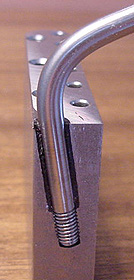A friend calls, he knows I am a pack rat of sorts when it comes to guitars parts and accessories.
Knobs, bridges, straps...I have many.
Pedals, effects, still a large pile.
He wants two of my pedals, and would like to trade.
I know the music community is small and local, but this is nuts! I make a trade with one friend in town a month ago and now I get a call for another trade offer. How's about a gig, instead?
I'm open, I'll listen. It's his dime. (Actually, that phrase no longer applies, notice?)
After he beats about the bush for a minute or two he names two Danelectro pedals of mine, one of which is a bit of a 'find.' The two together are worth $150 new, these are well used.
I'm thinking half.
Would I take a Callaham Trem Block and fitted 64 arm in trade? They are worth $80 new. These are NOS (New/Old Stock) unopened but not exactly new.
Frank, have you been peeking at FB? (I had posed a question in a group I am part of; The Guitar Players Association about brass versus steel blocks) As a matter of fact, no. Frank is one of the very few people I know not on FB or so private he tells no one. Chalk it up to timing.
We agree on the trade and he promises to make it out here one day this week.
We shall see. On all counts.
As far as the block itself and the theory behind such things:
That perforated block of cast zinc that the bridge is standing upon is the tremolo block. Through it the strings are anchored in the body of the guitar. The more dense the material, the fewer vibrations from the strings will be lost as heat in the block - more energy applied to the strings...an increase in sustain. The other sales point, and this one is not verified by any means, is that the material adds in some way to the sound of the guitar, usually the adjective is "resonance."
You can see the one pictured is tapered as well, less mass than a "squared" off block. The change in material from steel to zinc as well as the taper were done to reduce costs in manufacture.
Now we are talking about something like this, instead. Cold rolled steel that is machined and the mating surface is polished to a mirror finish to ensure a good surface to surface mating.
They go further and make a new type of connection with the tremolo arm itself, the threads are anchored in a delrin plug and angled and shallow. The arm is tight as a result even when turned away. A regular strat arm when not in use, flops around.
I like this...
"If you have an import guitar, your block is more than likely zinc (pot metal). Zinc kills both sustain and clarity and your sound. If you have a U.S. made guitar, you may have a steel block but it is either a hot rolled leaded steel, or in the case of the American Standard bridges, a soft cast steel block.
We guarantee you will hear the improvement after installing our block in both sustain and clarity."
Normally I would be arguing a change in material would have such a small effect as to be negligible, at least as far as human hearing in concerned.
But I keep coming back to the springs. The counterbore for the string end is at the bottom of the block by the springs and not at the top by the bridge. More of the strings pass through the block. The block is more dense than the Zinc cast block.
We.shall.see.



